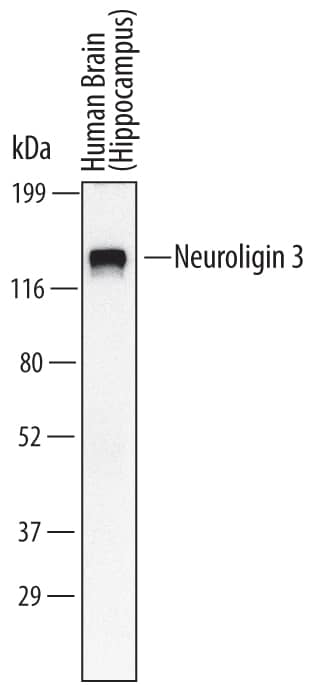Human Neuroligin 3/NLGN3 Antibody
R&D Systems, part of Bio-Techne | Catalog # MAB60881

Key Product Details
Species Reactivity
Applications
Label
Antibody Source
Product Specifications
Immunogen
Gln38-Ser709
Accession # NP_061850
Specificity
Clonality
Host
Isotype
Scientific Data Images for Human Neuroligin 3/NLGN3 Antibody
Detection of Human Neuroligin 3/NLGN3 by Western Blot.
Western blot shows lysates of human brain (hippocampus) tissue. PVDF Membrane was probed with 2 µg/mL of Human Neuroligin 3/NLGN3 Monoclonal Antibody (Catalog # MAB60881) followed by HRP-conjugated Anti-Mouse IgG Secondary Antibody (Catalog # HAF007). A specific band was detected for Neuroligin 3/NLGN3 at approximately 120 kDa (as indicated). This experiment was conducted under reducing conditions and using Immunoblot Buffer Group 1.Applications for Human Neuroligin 3/NLGN3 Antibody
Western Blot
Sample: Human brain (hippocampus) tissue
Formulation, Preparation, and Storage
Purification
Reconstitution
Formulation
Shipping
Stability & Storage
- 12 months from date of receipt, -20 to -70 °C as supplied.
- 1 month, 2 to 8 °C under sterile conditions after reconstitution.
- 6 months, -20 to -70 °C under sterile conditions after reconstitution.
Background: Neuroligin 3/NLGN3
NLGN3 (Neuroligin 3; also gliotactin homolog) is a 110-114 kDa member of the type-B carboxyesterase/lipase family of proteins. It is a neuronal transmembrane protein that forms Ca++-dependent intercellular junctions with short beta-neurexin isoforms. This seems to contribute to both glutamatergic and GABAergic synapse formation. Mutations in NLGN3 are associated with a reduction in protein expression and the occurrence of autism. Mature human NLGN3 is an 811 amino acid (aa) type I transmembrane protein. It contains a 672 aa extracellular domain (ECD) (aa 38-709), plus a 118 aa cytoplasmic region. The ECD possesses a nonfunctional carboxyesterase domain (aa 41-625). Multiple splice variants exist. There is a deletion of aa 153-172 that may also be accompanied by an alternative start site at Met118, and a deletion of aa 153-192 that may also be accompanied by a five
Alternate Names
Entrez Gene IDs
Gene Symbol
UniProt
Additional Neuroligin 3/NLGN3 Products
Product Documents for Human Neuroligin 3/NLGN3 Antibody
Product Specific Notices for Human Neuroligin 3/NLGN3 Antibody
For research use only
